The first line of code was written less than 150 years ago. The building of the first computers hasn't even celebrated its first 100th anniversary yet. The successful Apollo 11 moon mission was launched less than 50 years ago.
Now powerful and fancy conversational artificial intelligence (AI) such as ChatGPT are available at your fingertips to answer any question, from quantum computing to the best donut recipe.
It’s quite a fascinating evolution - if you are hyped up by its potential, well, you are not alone.
Markets based on new technological inventions currently grow at a lightspeed pace: the global AI market was valued at $119.78 billion in 2022 and is predicted to reach $1,597.1 billion by 2030, with a steady growth of 38.1% from 2022 to 2030.
What does it mean to businesses and decision makers? Let us help you understand it more deeply.
We spared you the hours of investigating and breaking down the processes that suggest these numbers – in the next 10 minutes of reading, we’re providing you with a solid summarization of the most recent papers from scholars, McKinsey & Company, and Forbes Insights sprinkled on top with our CEO’s conclusions.
Ready?
Not new, but cool
AI (here defined as an intelligent, thinking machine) is not a new idea - its core concept first popped up in the minds of ancient Greek philosophers, and its conceptual background was laid down in the 1950s in America.
However, it has attracted significant business attention in the last half-decade, because from 2000 to 2010, there was a boom in AI products for domestic and business use mostly due to the expanding data storage capacities.
Boom again: AI adoption has more than doubled since 2017 when only 20% of McKinsey & Company’s state of AI in 2022 report respondents stated that they were using AI in at least one business area, whereas today, that figure stands at 50%.
According to TechRepublic’s survey report, out of 500 CEOs, only 1% responded that they are not even considering the deployment of AI to some extent, and the Garter 2022 CEO survey also confirms the importance of AI for business leaders. However, we can see that many are still hesitant, tiptoeing towards AI deployment in their companies, despite its fame.
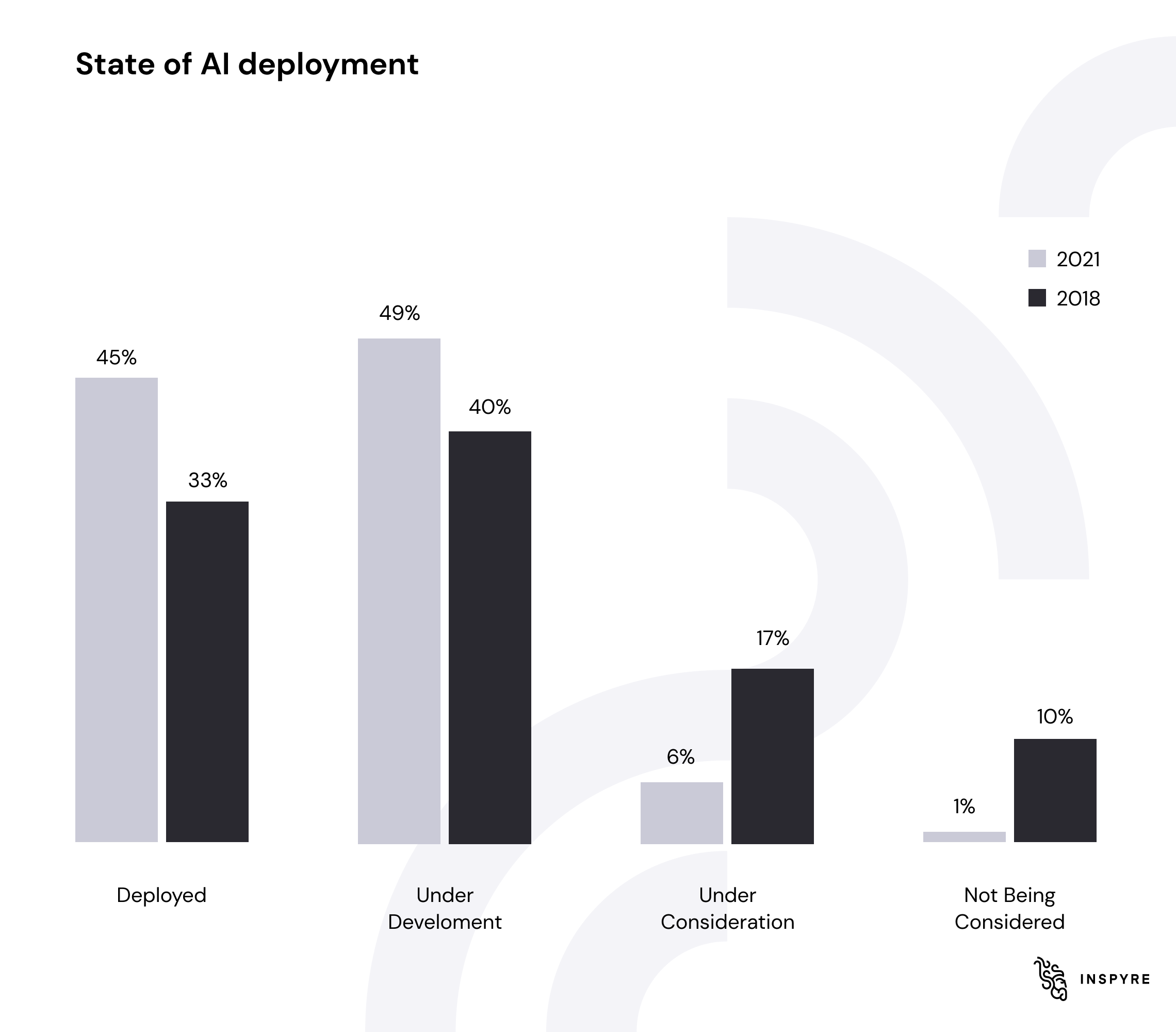
This is nothing new for technology veterans and battle-hardened CEOs: innovative technology never becomes widespread overnight. Some early adopters mine its potential before other competitors and gain a significant advantage, but others wake up later and are hesitant to fully engage in deploying the new technologies.
“Considering these steadily growing figures, business leaders who refuse to adopt AI may find themselves at a significant disadvantage both technically and financially in the years to come,” as Péter Borzák, CEO of INSPYRE Informatics stated. “The time to start getting familiar with AI is now; those who wait too long may find themselves struggling to catch up."
Even so, many societal and technological barriers remain in the way of AI attaining its full potential.
The main underlying cause can be surprisingly simple: the capabilities, the actual potentials, and the usability of it seem to lack understanding from the stakeholders.
So, to see clearer: what the heck AI is nowadays?
Its concept has far outgrown the idea of a talkative computer: we can now define AI as a wide range of technologies that promise a variety of benefits to enterprises in terms of additional business value, according to the mentioned study above, conducted by the Norwegian University of Science and Technology.
Though we need to mention that most scholars follow two main approaches towards defining AI: the first type refers to its functions as a tool/technology that solves a specific task that could be impossible or very time-consuming for a human to complete, and the second is that it mimics human intelligence and cognitive processes, such as interpreting, making inferences, and learning.
Seems quite far from everyday life. Let’s break down the definition to dig deeper.
1. AI = Wide range of technologies
If you're from the rather hesitant group when it comes to AI, here are some everyday examples that incorporate AI, and you've most probably encountered at least one of them:[1]:
· Email spam filters
· Predictive search terms
· Siri virtual assistant
· Online virtual assistant
· Facebook-recommended news
· Online shopping recommendations
· Home virtual assistant
· Reverse image searching
In a PEGA survey, 6000 adults from EMEA, APAC, and North America were asked whether they have ever used an AI-powered service. Only 30% of them responded that they did - in fact, after ticking this list, this number grows to 77%.
As you can see AI technologies’ application areas are vast: but they are made up of not dark magic, but their operation is a result of technologies such as computer vision, expert systems or natural language processing (NLP) – which combined with machine learning equals the base of chatbots, in case of the famous ChatGPT, too.
“When looking at the AI market, two solutions seem to be the most significant from IT vendors: they rather offer a so-called “boxed” preset-AI solution designed for a certain task - such as face recognition of cameras or proofreading, - that decision makers can buy, and use instantly” as Péter Borzák, CEO of INSPYRE Informatics, pointed out. “It's worth mentioning that many of these “boxed” solutions are low-hanging fruits and can be implemented way easier than developing a whole new framework.” he noted.
2. AI = Variety of benefits to enterprises in terms of additional business value
Based on our latest knowledge, AI is the strongest in IT optimization, marketing and sales, risk, and compliance areas, alongside service operation and product/service development.
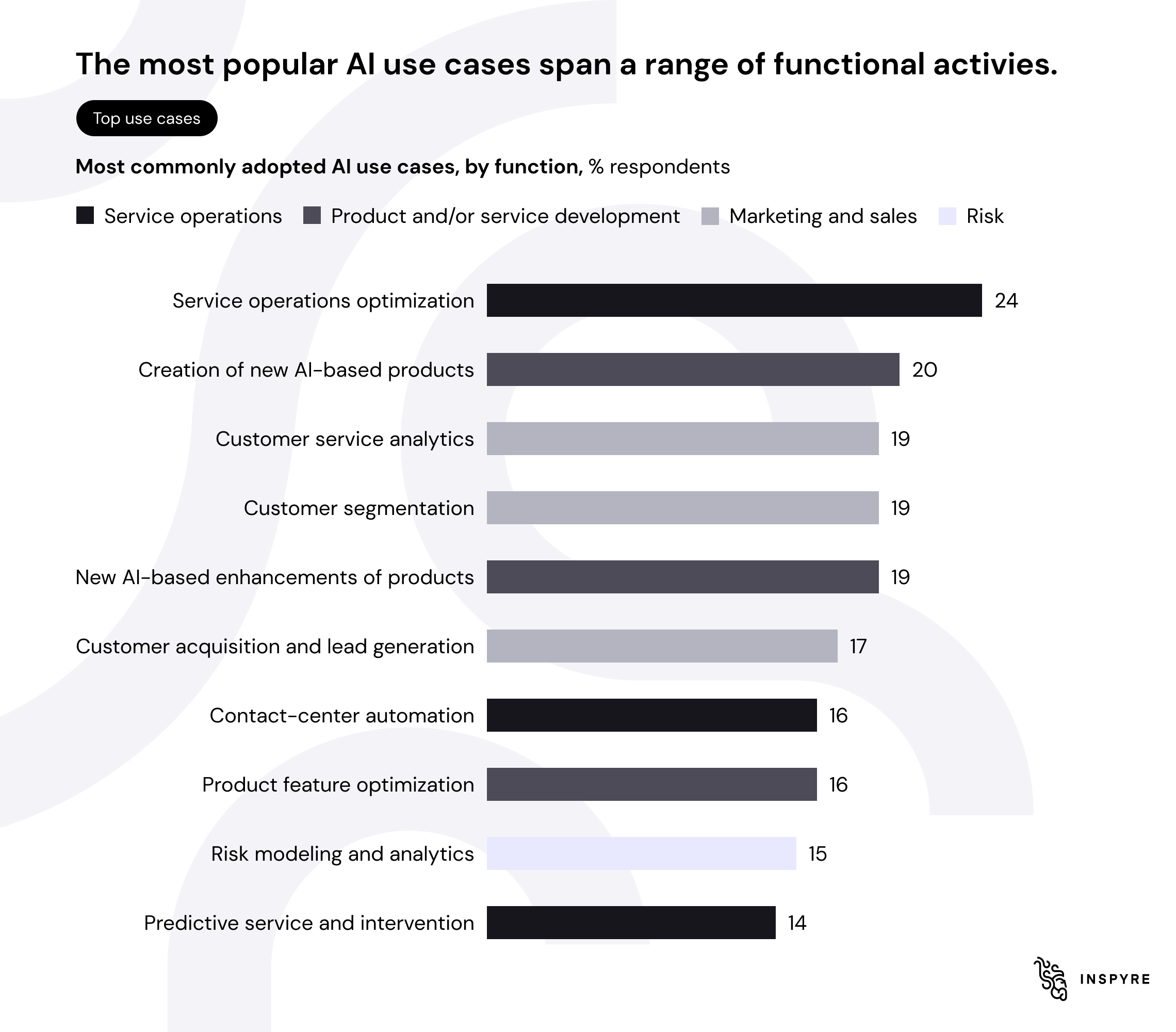
“To better understand these insights: the optimization of services merely means simplifying ongoing processes. Let’s take ChatGPT for example - if a colleague is working with Excel daily, chances are you can increase their productivity by adding a plug-in to the program powered by and connected to ChatGPT, where the employee can easily search for the formula needed for the next calculations, simply by describing it with terms – this way you both spare the cost of their Excel training and speed up their processes.
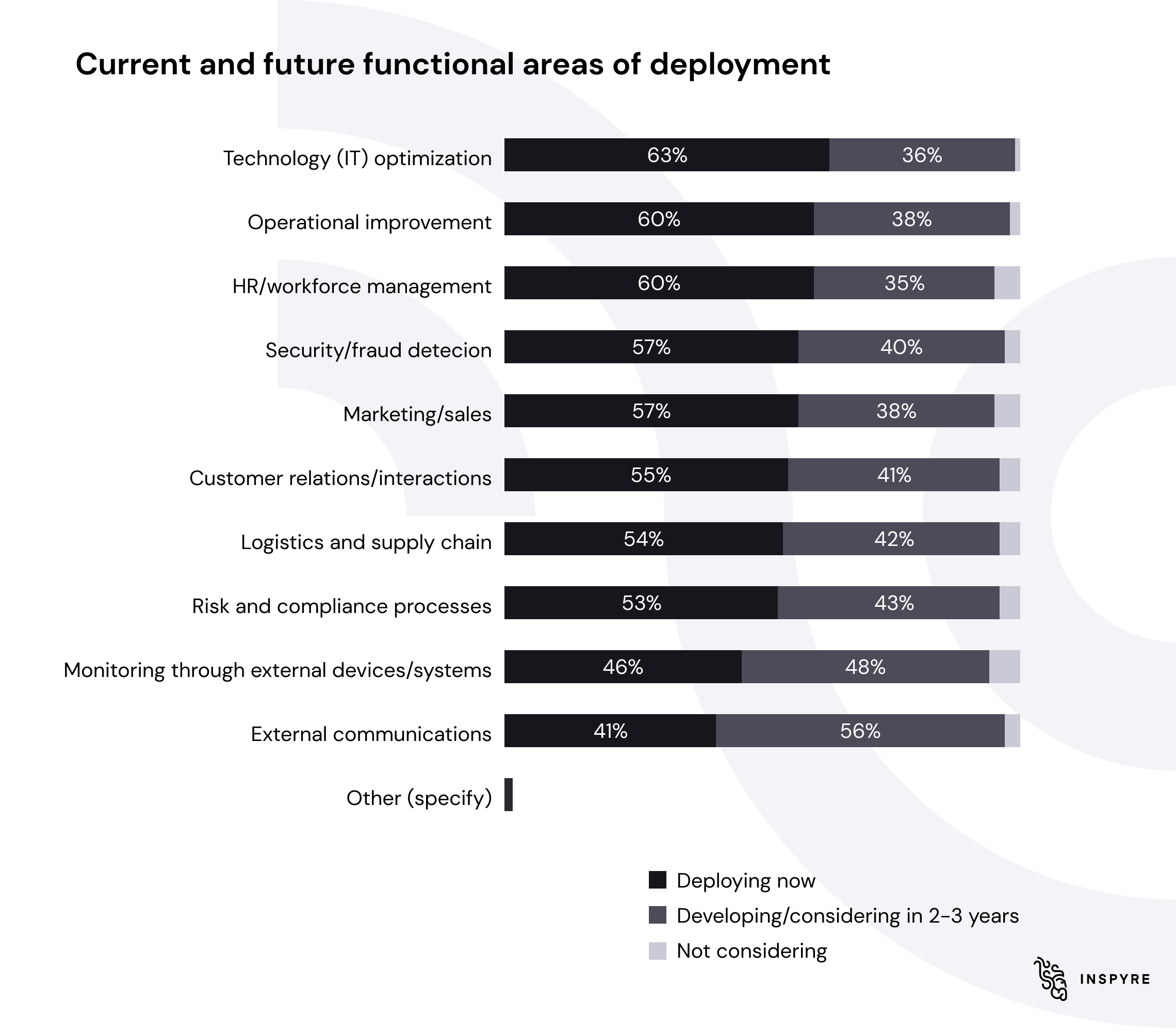
Or let’s say you need face recognition for the cameras in your HQ to ensure greater security. AI-powered solutions can elevate it to the next level, for example, by sending a warning to the police or to you when an unknown face enters the facility.
These are just a few real-life examples that even our team is capable of doing. Their main goal is to grab your attention: such things are not science fiction anymore.
Apart from these numbers, I suggest that you view AI as a tool: let’s say AI solutions can be your hammer, drilling machine, depending on your business's particular needs” – as the CEO of INSPYRE Informatics explained.
Implementing and applying AI
The most common challenge for implementing such “drilling machines” in a business operation is surprisingly not financial: only 8% of TechRepublic’s 2022 AI Momentum survey respondents name money as their main obstacle. Instead, decision-makers point out that technical or workflow issues are more of a problem regarding AI applicability.
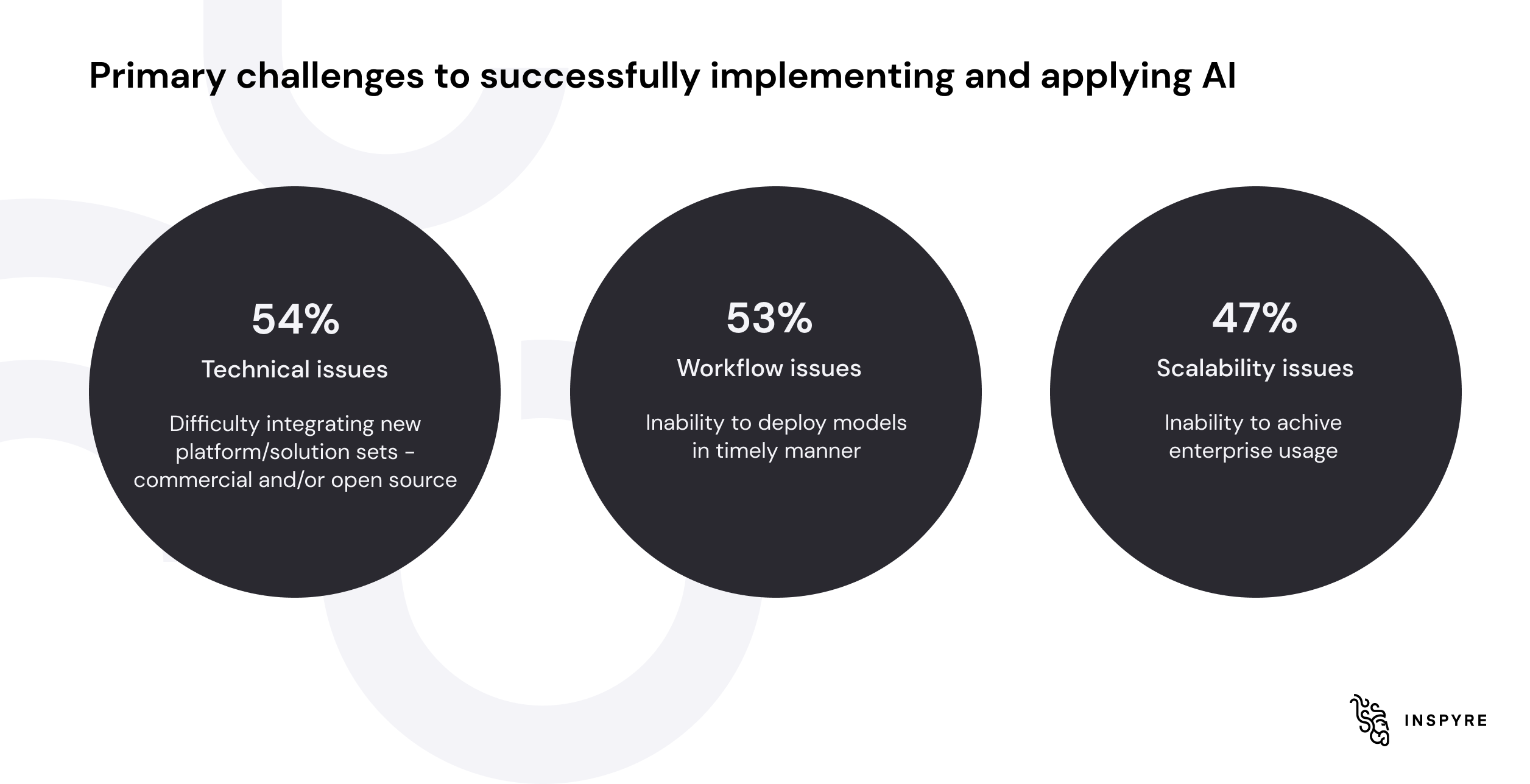
In the matter of trust in AI, the TechRepublic survey found mixed results: 73% of respondents stated that they trust AI to make the appropriate predictions and suggested actions, but 63% agreed with the statement that they do not understand AI enough to fully appreciate whether it will benefit their organization or not. Another 51% declared their trust issues towards an AI-generated response or solution.
When it comes to perspective and how a company can successfully add AI-powered solutions in supporting its operation, we need to mention that innovative work cultures are more likely to accept and foster AI technologies because they have a passion for and willingness to develop innovative entrepreneurial ideas.
Such work environments can also counteract one’s built-in bias against AI: open-mindedness and objective evaluation are more common in a disruptive environment where people’s curious approach and eagerness to learn can aid break down the existing hesitancy and mistrust of others.
As a result, firms with a creative culture are better positioned to integrate AI into their workflow – and they are also ideal candidates for supporting others to do so.
When it comes to the measurement of AI applications, we can spot that most companies’ AI solutions are built by prepared vendors.
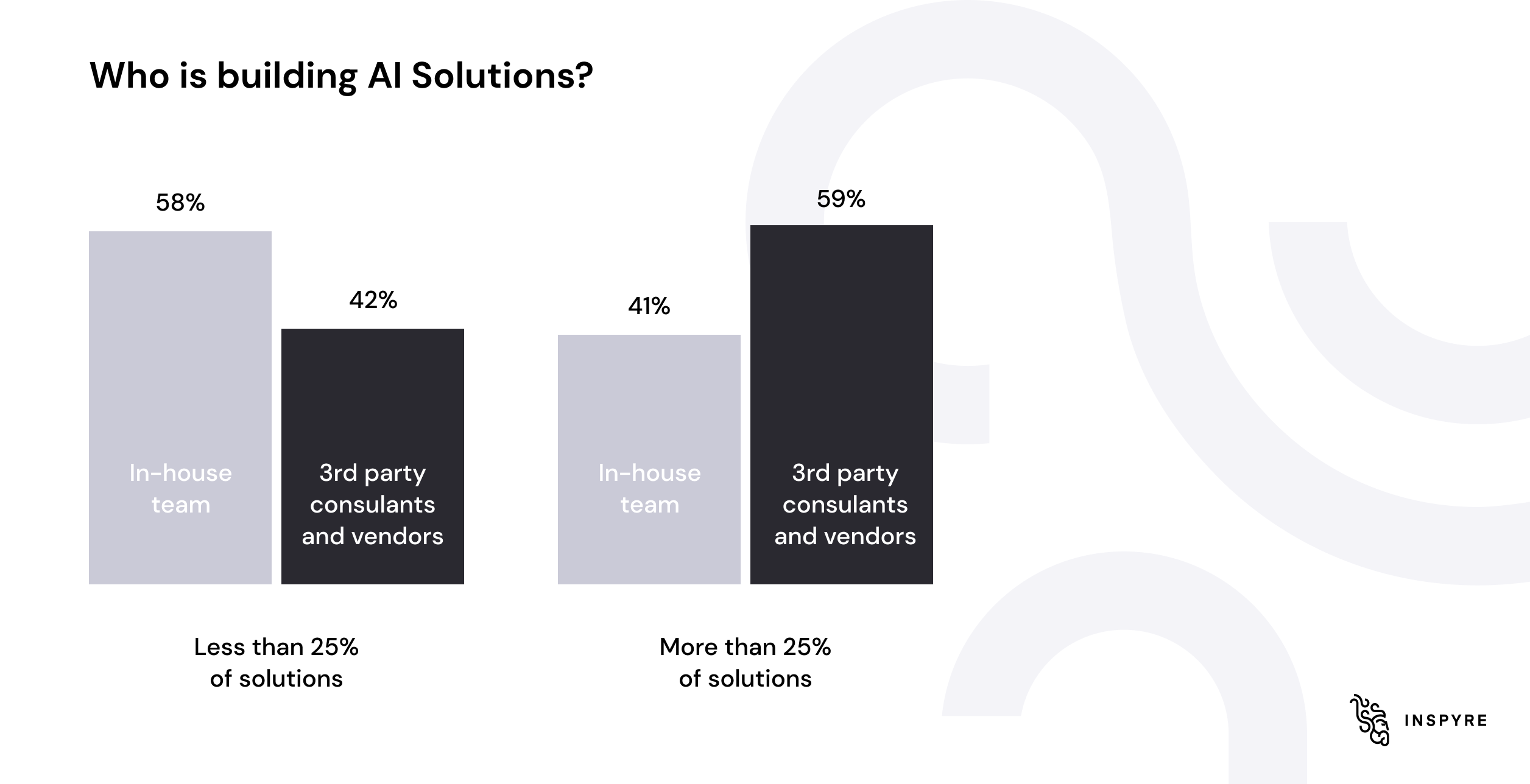
“What AI can be used for is greatly depending on one’s capabilities and the possibilities of AI today. We need to note here that what AI is capable of today is not what it is going to be capable of tomorrow.
Keep a neutral, but a curious eye on it when it comes to growing your business and expanding your horizons” – as the CEO of INSPYRE Informatics, concluded.
Conclusion
In a conclusion, we can summarize that AI technologies are now steadily rising as business solutions and reached a tipping point in the last half-decade, by becoming a more and more potent force.
Here are some key insights:
· AI is still on the rise.
· The AI market is expected to be highly profitable and grow steadily and many leaders invest in it.
· AI is evolving and can now be defined as a range of technologies that promise a variety of benefits to enterprises in terms of additional business value.
· AI is the strongest in IT optimization, marketing and sales, risk, and compliance, operation, and product/service development.
· It is natural that people are careful with new technologies. Although innovative work culture can foster openness toward such new solutions.
Enjoyed reading it?
If you found this article informative, consider sharing it with a collegaue ♡
Author, editor:
Henriett Kóti
Communications Specialist
henriett.koti@inspyre.it
[1] The categories are the exact same ones what was used in a global PEGA survey to measure the average use of AI in users.
